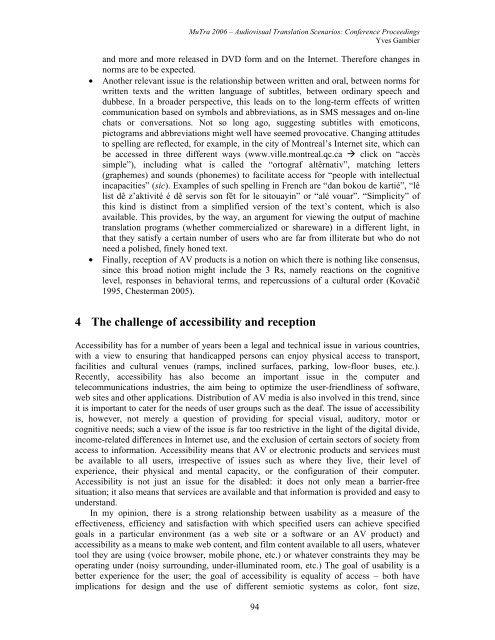Proceedings - Translation Concepts
Proceedings - Translation Concepts
Proceedings - Translation Concepts
You also want an ePaper? Increase the reach of your titles
YUMPU automatically turns print PDFs into web optimized ePapers that Google loves.
MuTra 2006 – Audiovisual <strong>Translation</strong> Scenarios: Conference <strong>Proceedings</strong><br />
Yves Gambier<br />
and more and more released in DVD form and on the Internet. Therefore changes in<br />
norms are to be expected.<br />
• Another relevant issue is the relationship between written and oral, between norms for<br />
written texts and the written language of subtitles, between ordinary speech and<br />
dubbese. In a broader perspective, this leads on to the long-term effects of written<br />
communication based on symbols and abbreviations, as in SMS messages and on-line<br />
chats or conversations. Not so long ago, suggesting subtitles with emoticons,<br />
pictograms and abbreviations might well have seemed provocative. Changing attitudes<br />
to spelling are reflected, for example, in the city of Montreal’s Internet site, which can<br />
be accessed in three different ways (www.ville.montreal.qc.ca click on “accès<br />
simple”), including what is called the “ortograf altêrnativ”, matching letters<br />
(graphemes) and sounds (phonemes) to facilitate access for “people with intellectual<br />
incapacities” (sic). Examples of such spelling in French are “dan bokou de kartié”, “lê<br />
list dê z’aktivité é dê servis son fêt for le sitouayin” or “alé vouar”. “Simplicity” of<br />
this kind is distinct from a simplified version of the text’s content, which is also<br />
available. This provides, by the way, an argument for viewing the output of machine<br />
translation programs (whether commercialized or shareware) in a different light, in<br />
that they satisfy a certain number of users who are far from illiterate but who do not<br />
need a polished, finely honed text.<br />
• Finally, reception of AV products is a notion on which there is nothing like consensus,<br />
since this broad notion might include the 3 Rs, namely reactions on the cognitive<br />
level, responses in behavioral terms, and repercussions of a cultural order (Kovačič<br />
1995, Chesterman 2005).<br />
4 The challenge of accessibility and reception<br />
Accessibility has for a number of years been a legal and technical issue in various countries,<br />
with a view to ensuring that handicapped persons can enjoy physical access to transport,<br />
facilities and cultural venues (ramps, inclined surfaces, parking, low-floor buses, etc.).<br />
Recently, accessibility has also become an important issue in the computer and<br />
telecommunications industries, the aim being to optimize the user-friendliness of software,<br />
web sites and other applications. Distribution of AV media is also involved in this trend, since<br />
it is important to cater for the needs of user groups such as the deaf. The issue of accessibility<br />
is, however, not merely a question of providing for special visual, auditory, motor or<br />
cognitive needs; such a view of the issue is far too restrictive in the light of the digital divide,<br />
income-related differences in Internet use, and the exclusion of certain sectors of society from<br />
access to information. Accessibility means that AV or electronic products and services must<br />
be available to all users, irrespective of issues such as where they live, their level of<br />
experience, their physical and mental capacity, or the configuration of their computer.<br />
Accessibility is not just an issue for the disabled: it does not only mean a barrier-free<br />
situation; it also means that services are available and that information is provided and easy to<br />
understand.<br />
In my opinion, there is a strong relationship between usability as a measure of the<br />
effectiveness, efficiency and satisfaction with which specified users can achieve specified<br />
goals in a particular environment (as a web site or a software or an AV product) and<br />
accessibility as a means to make web content, and film content available to all users, whatever<br />
tool they are using (voice browser, mobile phone, etc.) or whatever constraints they may be<br />
operating under (noisy surrounding, under-illuminated room, etc.) The goal of usability is a<br />
better experience for the user; the goal of accessibility is equality of access – both have<br />
implications for design and the use of different semiotic systems as color, font size,<br />
94
















